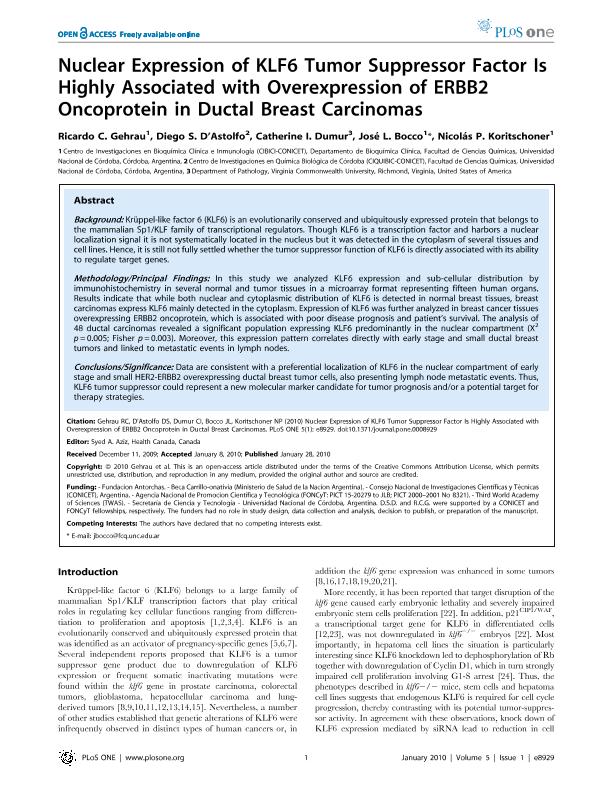Mostrar el registro sencillo del ítem
dc.contributor.author
Gehrau, Ricardo Carlos

dc.contributor.author
D'astolfo, Diego Sebastian

dc.contributor.author
Dumur, Catherine I.
dc.contributor.author
Bocco, Jose Luis

dc.contributor.author
Koritschoner, Nicolas Pedro

dc.date.available
2023-02-07T14:11:46Z
dc.date.issued
2010-01
dc.identifier.citation
Gehrau, Ricardo Carlos; D'astolfo, Diego Sebastian; Dumur, Catherine I.; Bocco, Jose Luis; Koritschoner, Nicolas Pedro; Nuclear expression of KLF6 tumor suppressor factor is highly associated with overexpression of ERBB2 oncoprotein in ductal breast carcinomas; Public Library of Science; Plos One; 28; 1; 1-2010; 1-11
dc.identifier.issn
1932-6203
dc.identifier.uri
http://hdl.handle.net/11336/187188
dc.description.abstract
Background: Kru¨ppel-like factor 6 (KLF6) is an evolutionarily conserved and ubiquitously expressed protein that belongs to the mammalian Sp1/KLF family of transcriptional regulators. Though KLF6 is a transcription factor and harbors a nuclear localization signal it is not systematically located in the nucleus but it was detected in the cytoplasm of several tissues and cell lines. Hence, it is still not fully settled whether the tumor suppressor function of KLF6 is directly associated with its ability to regulate target genes. Methodology/Principal Findings: In this study we analyzed KLF6 expression and sub-cellular distribution by immunohistochemistry in several normal and tumor tissues in a microarray format representing fifteen human organs. Results indicate that while both nuclear and cytoplasmic distribution of KLF6 is detected in normal breast tissues, breast carcinomas express KLF6 mainly detected in the cytoplasm. Expression of KLF6 was further analyzed in breast cancer tissues overexpressing ERBB2 oncoprotein, which is associated with poor disease prognosis and patient’s survival. The analysis of 48 ductal carcinomas revealed a significant population expressing KLF6 predominantly in the nuclear compartment (X2 p = 0.005; Fisher p = 0.003). Moreover, this expression pattern correlates directly with early stage and small ductal breast tumors and linked to metastatic events in lymph nodes. Conclusions/Significance: Data are consistent with a preferential localization of KLF6 in the nuclear compartment of early stage and small HER2-ERBB2 overexpressing ductal breast tumor cells, also presenting lymph node metastatic events. Thus, KLF6 tumor suppressor could represent a new molecular marker candidate for tumor prognosis and/or a potential target for therapy strategies.
dc.format
application/pdf
dc.language.iso
eng
dc.publisher
Public Library of Science

dc.rights
info:eu-repo/semantics/openAccess
dc.rights.uri
https://creativecommons.org/licenses/by/2.5/ar/
dc.subject
TUMOR SUPPRESSOR GENES
dc.subject
ONCOGENES
dc.subject
KLF6
dc.subject
CELL PROLIFERATION
dc.subject.classification
Bioquímica y Biología Molecular

dc.subject.classification
Ciencias Biológicas

dc.subject.classification
CIENCIAS NATURALES Y EXACTAS

dc.title
Nuclear expression of KLF6 tumor suppressor factor is highly associated with overexpression of ERBB2 oncoprotein in ductal breast carcinomas
dc.type
info:eu-repo/semantics/article
dc.type
info:ar-repo/semantics/artículo
dc.type
info:eu-repo/semantics/publishedVersion
dc.date.updated
2023-01-31T12:34:12Z
dc.identifier.eissn
1873-507X
dc.journal.volume
28
dc.journal.number
1
dc.journal.pagination
1-11
dc.journal.pais
Estados Unidos

dc.journal.ciudad
San Francisco
dc.description.fil
Fil: Gehrau, Ricardo Carlos. Consejo Nacional de Investigaciones Científicas y Técnicas. Centro Científico Tecnológico Córdoba. Centro de Investigaciones en Bioquímica Clínica e Inmunología; Argentina. Universidad Nacional de Córdoba. Facultad de Ciencias Químicas. Departamento de Bioquímica Clínica; Argentina
dc.description.fil
Fil: D'astolfo, Diego Sebastian. Consejo Nacional de Investigaciones Científicas y Técnicas. Centro Científico Tecnológico Conicet - Córdoba. Centro de Investigaciones en Química Biológica de Córdoba. Universidad Nacional de Córdoba. Facultad de Ciencias Químicas. Centro de Investigaciones en Química Biológica de Córdoba; Argentina
dc.description.fil
Fil: Dumur, Catherine I.. Virginia Commonwealth University; Estados Unidos
dc.description.fil
Fil: Bocco, Jose Luis. Consejo Nacional de Investigaciones Científicas y Técnicas. Centro Científico Tecnológico Córdoba. Centro de Investigaciones en Bioquímica Clínica e Inmunología; Argentina. Universidad Nacional de Córdoba. Facultad de Ciencias Químicas. Departamento de Bioquímica Clínica; Argentina
dc.description.fil
Fil: Koritschoner, Nicolas Pedro. Consejo Nacional de Investigaciones Científicas y Técnicas. Centro Científico Tecnológico Córdoba. Centro de Investigaciones en Bioquímica Clínica e Inmunología; Argentina. Universidad Nacional de Córdoba. Facultad de Ciencias Químicas. Departamento de Bioquímica Clínica; Argentina
dc.journal.title
Plos One

dc.relation.alternativeid
info:eu-repo/semantics/altIdentifier/url/https://journals.plos.org/plosone/article/comments?id=10.1371/journal.pone.0008929
dc.relation.alternativeid
info:eu-repo/semantics/altIdentifier/doi/http://dx.doi.org/10.1371/journal.pone.0008929
Archivos asociados
